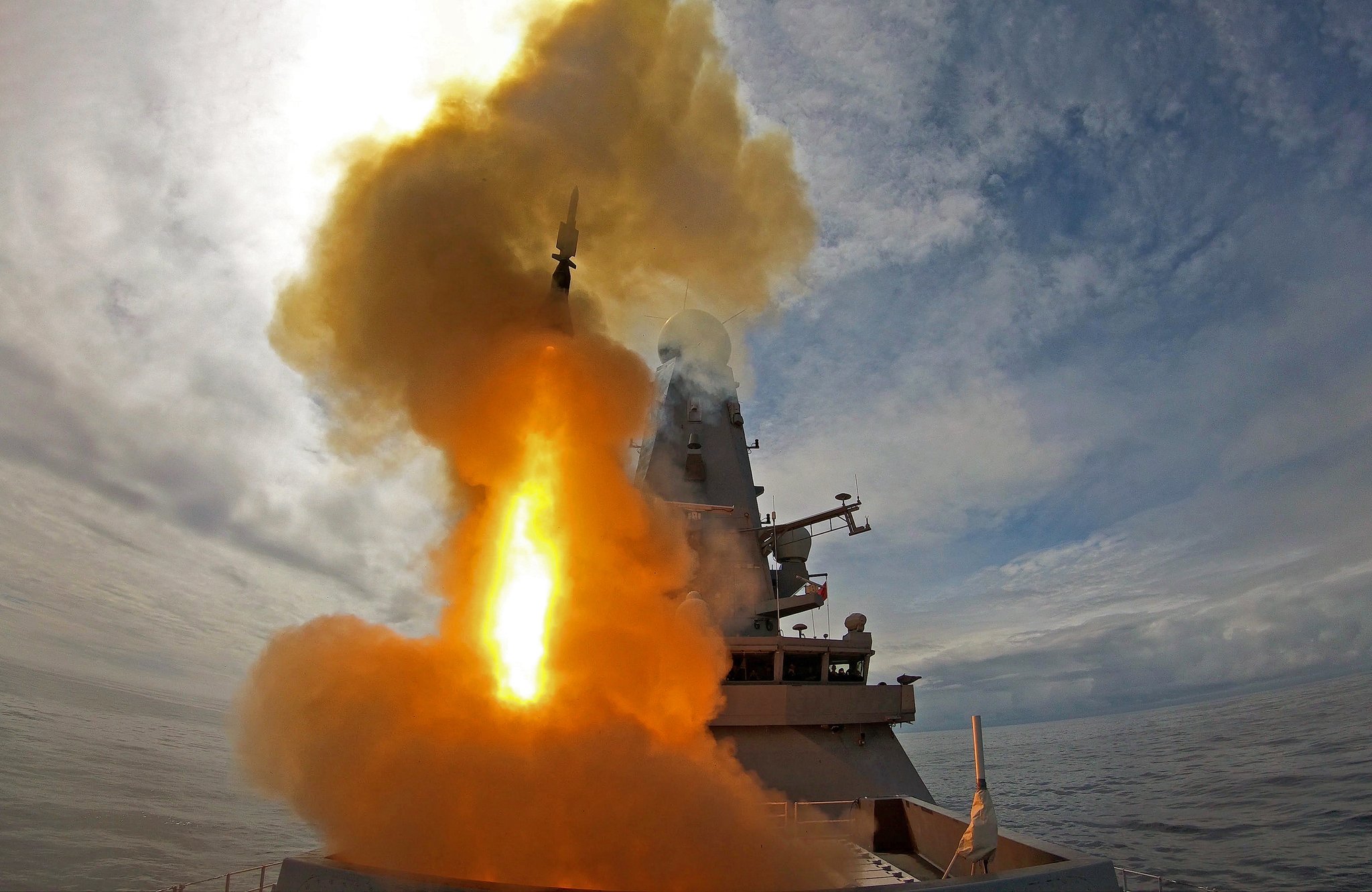I actually think that it illustrates a more serious and insidious problem; the current inability to reload VLS cells whilst at sea. You can have 122 VLS cells BUT once you have expended those you are a waste of time until you can return to a friendly port and reload alongside. In European waters this may not be such a large issue, but in Asia Pacific waters, the nearest friendly port maybe be several thousand nautical miles away through potentially unfriendly territory.
HMS Diamond ‘not enough missiles’ for sustained fight
"It's almost comical to think about targeting HMS Diamond, of all ships, with a missile. It's like deciding to punch Muhammad Ali and expecting to land a decent hit."ukdefencejournal.org.uk

The OSINT Bunker - News Snapshots - The OSINT Bunker - News Snapshots S1E01 (13th January 2024) | RSS.com
Season 1 - Episode 1 //News Snapshots is the new fortnightly news podcast from The OSINT Bunker team //13th January 2024 - Discussing Op Propserity Guardian in the Red Sea, the ongoing situation in Israel and Gaza, and predictions for the Ukraine-Russia conflict as 2024 begins. //Featuring...rss.com
Lets see how the Houti blockade will change the number of VLS on European navies.
The Royal Navy Discussions and Updates
- Thread starter overlander
- Start date
Recently in Canada a Navy commander suggested acquiring large uncrewed surface vessels that carry VLS cells to accompany our forthcoming CSC frigates (since there has been a fair bit of discussion on lack of VLS cells they will have) (also will try to look for the source of comments and post). Lets say you can build several LUSV with 32 cell Mk41's; you could then deploy to the Red Sea area and simply swap out the LUSV instead of the destroyer/frigate returning to a home or friendly port after shooting a few waves of Houthi drones and missiles. Obviously easier said than done, but if it can be done this would be a significant force multiplier.I actually think that it illustrates a more serious and insidious problem; the current inability to reload VLS cells whilst at sea. You can have 122 VLS cells BUT once you have expended those you are a waste of time until you can return to a friendly port and reload alongside. In European waters this may not be such a large issue, but in Asia Pacific waters, the nearest friendly port maybe be several thousand nautical miles away through potentially unfriendly territory.
Cost is another problem; using $5+ million dollar SM-2's / 6's or Aster 30's to shoot down $50K drones isn't viable in the long term. I did notice something interesting a while back though:
MBDA, Poland’s PGZ to develop medium-range air defense missile (defensenews.com)
MBDA is announcing a medium ranged CAMM (100+KM) that can be dual packed in a Mk41 cell. MBDA is also calling this missile a "low-cost interceptor" which is the first time I recall seeing language like used to promote a modern interceptor. It will be interesting to see exactly what the cost of this interceptor will be but I think it's smart of MBDA to explore; not every maritime missile / drone threat needs the top end SM-6 or Aster-30 missile capabilities. So, in a Red Sea scenario, you could load up your 32 cell LUSV(s) with "cheaper" missiles and keep your top tier missiles reserved for more advanced threats.
I think we will see a few different developments in this area in the next few years, could be interesting.
1-Way cheaper, to engage with 3 rounds of DARTS cost around 90k-100k
2-Thanks to NS-30 the bottleneck that was one target per time is over. Opening to the high rate of fire of the 76mm.

 electronics.leonardo.com
electronics.leonardo.com
So I would say the 76mm is the perfect weapon against a slow moving drone like a shaded, at 180km/h even if the STRALES miss you would still have time to launch more expensive solutions like missiles. You could engage in its 8km range dozens of drones without problems.
Against high subsonic? Don't know to be honest. Still something like a SPEAR 3 is high subsonic and has a price range of around 200k. Anything you are going to launch at it is going to be a net loss. Unless you are using something like the Tamir from the Iron Dome that should cost 60k per missile.
2-Thanks to NS-30 the bottleneck that was one target per time is over. Opening to the high rate of fire of the 76mm.

NA-30S MK2
So I would say the 76mm is the perfect weapon against a slow moving drone like a shaded, at 180km/h even if the STRALES miss you would still have time to launch more expensive solutions like missiles. You could engage in its 8km range dozens of drones without problems.
Against high subsonic? Don't know to be honest. Still something like a SPEAR 3 is high subsonic and has a price range of around 200k. Anything you are going to launch at it is going to be a net loss. Unless you are using something like the Tamir from the Iron Dome that should cost 60k per missile.

In first, UK downs aerial drone with test shot from DragonFire laser
The trial with the direct-energy weapon is considered a significant milestone toward the deployment of the system, possibly within five years.
At 10 quid a shot this has the potential to bet all options, but in saying that I dont know if this system can track a high speed moving target or if the drone has to be all but stationary.
Reading further it looks like that Dragon fire laser can track high end targets. The Royal Navy are talking about integrating it to the type 26 in the early 2030's.
Last edited:
THIS activity used to be part of US Naval fleet routines, but was effectively killed off when they started Arleigh Burke construction.I actually think that it illustrates a more serious and insidious problem; the current inability to reload VLS cells whilst at sea. You can have 122 VLS cells BUT once you have expended those you are a waste of time until you can return to a friendly port and reload alongside. In European waters this may not be such a large issue, but in Asia Pacific waters, the nearest friendly port maybe be several thousand nautical miles away through potentially unfriendly territory.
Currently AFAIK, NO modern navy has this ability for VLS, so it's not unique.
With the right software in the command system & equipment (EO / IR tracker), 30mm's or CIWS/Phalanx would be a better option. I've personally seen 30mm take out 'an aerial target' at 3Km, travelling at circa 300kts (noting that this was over 15 years ago).Is there merit in having a 76 mm gun for drones and such, there can be different ammunition used to support the defence against subsonic cruise missiles ,instead of short range missiles with limited amounts?
John Fedup
The Bunker Group
Perhaps Millenuim 35mm with AHEAD ammo or 57 mm gun could be options to seriously consider.
I would consider the 57 with the programmable munition in a solution similar to the 76 Sovraponte (no deck penetration, in reality it penetrates but just a bit).
A classic 30mm CIWS, means you are reducing the range by 5km, a 62% less, it has had FF incidents in the past because the short time of engagement means high levels of automation, if you down the objective too near the ship you still risk getting the debris, etc.. etc..
Italians lack surely going out with only 16vls but IMHO at least we made the right choice on the CIWS field.
I really like the new french CIWS
Because IMHO the solution in the future are going to be cheaper rockets.
A classic 30mm CIWS, means you are reducing the range by 5km, a 62% less, it has had FF incidents in the past because the short time of engagement means high levels of automation, if you down the objective too near the ship you still risk getting the debris, etc.. etc..
Italians lack surely going out with only 16vls but IMHO at least we made the right choice on the CIWS field.
I really like the new french CIWS
Because IMHO the solution in the future are going to be cheaper rockets.
Or 40mm & 57mm with 3P ammo. We're currently building ships with the guns, & the ammunition's on order.Perhaps Millenuim 35mm with AHEAD ammo or 57 mm gun could be options to seriously consider.
I think a distinction needs to be made here on point vs area air defence against drones. There are many interesting gun based options developed or underway but these will be of limited use in a Red Sea situation where escorts are being tasked with protecting shipping lanes from these threats.
For area air defence, navies will need missile interceptors at scale (high numbers / low cost).
For area air defence, navies will need missile interceptors at scale (high numbers / low cost).
Or 40mm & 57mm with 3P ammo. We're currently building ships with the guns, & the ammunition's on order.
Exactly, it's either in or will be in, inventory and both the Mk4 and the 57Mm have good reputations in service.
If the 26's could bear the weight in RN service, I'd quite cheerfully swap out the 30mm cannons. I've heard informally that the direction is "40mm with everything" - which in the case of the batch 1 Rivers, seems to actually mean "take the 20mm off and have a pair of 50's on the bridge wings.
The Mk4 mount does seem quite a bit beefier however so I don't know if Type 26 can accept it. I'd assume both carriers would be perfectly fine. Dragonfire does seem an encouraging development of course.
The RN 'CONOPS' over the last 5 years is to move away from Mini-gun, with a 'mix-n-match' approach to GPMG / 0.50 Cal. is logical & may explain most vessels in the fleet starting to incorporate 50 Cal.If the 26's could bear the weight in RN service, I'd quite cheerfully swap out the 30mm cannons. I've heard informally that the direction is "40mm with everything" - which in the case of the batch 1 Rivers, seems to actually mean "take the 20mm off and have a pair of 50's on the bridge wings.
Practically speaking with regards swarm / fast attack, it has been proven that throwing 2000 RPM of 5.56mm at an incoming small boat, will NOT stop it at a sufficient (safe) distance. 50 Cal is much larger, has better kinetic energy & a couple of well placed 50 cal sniper rifle rounds into an outboard usually renders it useless. Similar approach with the traditional 'ma deuce', a couple of rounds into the hull of the boat, soon stops it in the water.
It is plausible over time that the 30mm could be replaced with 40mm on the likes of T26 / RN OPV's / Carrier, with T31 / T83 following suit, but with equipment / training costs & stockpiles of ammo, it is liable to be slow-time.
I thought T31 is leading the way: 1 x 57mm Mk 110 & 2 x 40mm Mk 4, according to the published informationIt is plausible over time that the 30mm could be replaced with 40mm on the likes of T26 / RN OPV's / Carrier, with T31 / T83 following suit, but with equipment / training costs & stockpiles of ammo, it is liable to be slow-time.
Type 31 Frigate | Navy Lookout.
Not sure if this is old news but just seen today.
Seems like a refit supervisor might have some questions to answer.
This is not the first time that engine controls have been compromised in refit either in the RN or RAN and no doubt others.

 www.navylookout.com
www.navylookout.com
Seems like a refit supervisor might have some questions to answer.
This is not the first time that engine controls have been compromised in refit either in the RN or RAN and no doubt others.

A naval accident in context – Royal Navy minehunters collide in Bahrain - Navy Lookout
Here we consider the implications of the unfortunate collision of two Royal Navy ships in Bahrain, seen in the wider context of peacetime naval accidents. Chiddingfold V Bangor On 19th January while manoeuvring in the harbour at Bahrain. HMS Chiddingfold struck HMS Bangor. Technically this was...
CO is still the poor bugger who'll be fronting a Courts Martial.Not sure if this is old news but just seen today.
Seems like a refit supervisor might have some questions to answer.
This is not the first time that engine controls have been compromised in refit either in the RN or RAN and no doubt others.

A naval accident in context – Royal Navy minehunters collide in Bahrain - Navy Lookout
Here we consider the implications of the unfortunate collision of two Royal Navy ships in Bahrain, seen in the wider context of peacetime naval accidents. Chiddingfold V Bangor On 19th January while manoeuvring in the harbour at Bahrain. HMS Chiddingfold struck HMS Bangor. Technically this was...www.navylookout.com
Not sure if this is old news but just seen today.
Seems like a refit supervisor might have some questions to answer.
This is not the first time that engine controls have been compromised in refit either in the RN or RAN and no doubt others.

A naval accident in context – Royal Navy minehunters collide in Bahrain - Navy Lookout
Here we consider the implications of the unfortunate collision of two Royal Navy ships in Bahrain, seen in the wider context of peacetime naval accidents. Chiddingfold V Bangor On 19th January while manoeuvring in the harbour at Bahrain. HMS Chiddingfold struck HMS Bangor. Technically this was...www.navylookout.com
I was chatting to a friend who had a front row seat from the harbour when it happened. A lot of slow-motion "nooooooo" happening on the bridges of both ships I'd guess.
Bangor was alongside, presumably in harbour routine, so probably nobody on the bridge. Suspect the QM and Bosun's Mate (and OOD if they had been standing by to pipe) would have need a change of white shorts though....... Captain might even have been ashore - imagine coming back and finding that!! Still the collision report would, from his perspective, have been easy - wind force 0, sea state 0, ship speed 0, ship location alongside wharf.
Last edited:
Bet it gave the people in the Port Office a scare! Best/Worst Parking Thread- Don't be shyYou’re not wrong there; I was sitting in the stream in Hobart when Perth decided to rearrange some of the waterfront in Hobart town…
